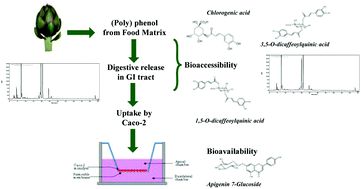Polyphenols from artichoke heads (Cynara cardunculus (L.) subsp. scolymus Hayek): in vitro bio-accessibility, intestinal uptake and bioavailability
Abstract
Artichoke is a rich source of health promoting compounds such as polyphenols, important for their pharmaceutical and nutritional properties. In this study, the potential for bioavailability of the artichoke polyphenols was estimated by using both in vitro digestion and Caco-2 human intestinal cell models. In vitro digestive recoveries (bio-accessibility) were found to be 55.8% for total artichoke phenolics and in particular, 70.0% for chlorogenic acid, 41.3% for 3,5-O-dicaffeoylquinic acid, and 50.3% for 1,5-O-dicaffeoylquinic acid, highlighting potential sensitivity of these compounds to gastric and small intestinal digestive conditions. Uptake of artichoke polyphenols was rapid with peak accumulation occurring after 30 min with an efficiency of 0.16%, according to the poor uptake of dietary polyphenols. Some compounds, such as coumaric acid, caffeic acid and caffeic acid derivatives, were also detected in the basolateral side assuming extra and intracellular esterase activities on chlorogenic acid. Only apigenin-7-O-glucoside was transported through the Caco-2 monolayer demonstrating its bioavailability to the extent of 1.15% at 60 min. In addition, permeability coefficient (Papp = 2.29 × 10−5 cm s−1), involving apical to basolateral transport of apigenin 7-O-glucoside, was calculated to facilitate estimation of transport through the Caco-2 monolayer. Finally, the mono and dicaffeoylquinic acids present in artichoke heads exert an antioxidant activity on the human low density lipoprotein system correlated to their chemical structure. In conclusion, the utilized in vitro models, although not fully responding to the morphological and physiological features of human in vivo conditions, could be a useful tool for investigating mechanistic effects of polyphenols released from the food matrix.


 Please wait while we load your content...
Please wait while we load your content...